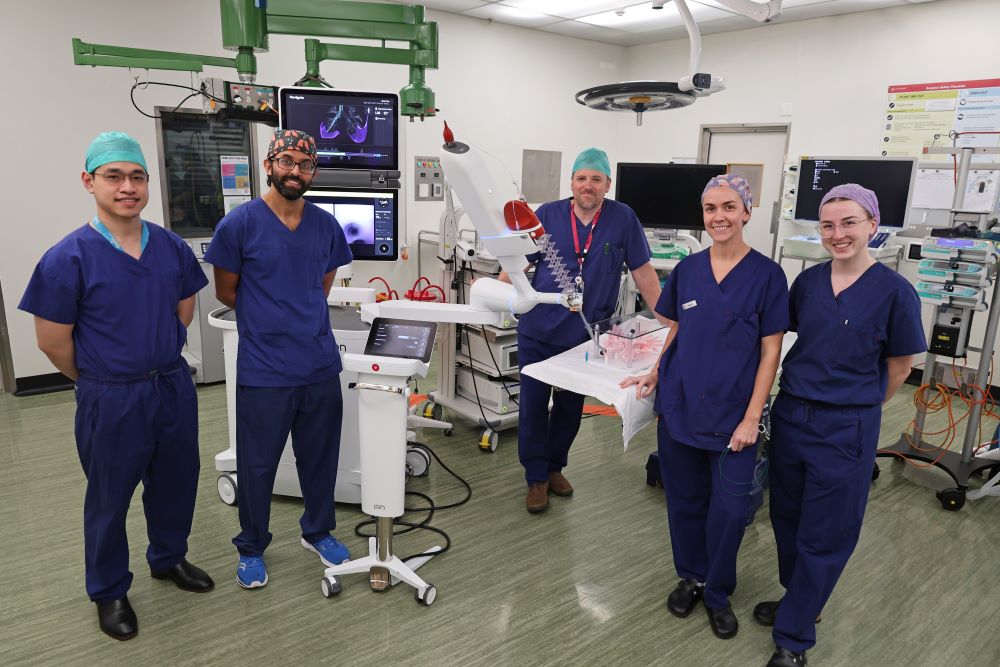Western Australia's first bronchoscopy robot saving lives
 Sir Charles Gairdner Hospital is the first hospital in Western Australia to provide robotic bronchoscopy procedures.
Sir Charles Gairdner Hospital is the first hospital in Western Australia to provide robotic bronchoscopy procedures.
16/07/2025
Sir Charles Gairdner Hospital (SCGH) is the first hospital in Western Australia to provide robotic bronchoscopy procedures, marking a major development in lung cancer diagnosis and care in the state.
SCGH is one of very few hospitals in Australia to use robotic bronchoscopy and is the first hospital to use this device integrated into routine clinical practice in Australia.
The Respiratory Team began undertaking robotic navigational bronchoscopies from Wednesday 2 July 2025.
SCGH Executive Director Jodi Graham thanked the SCGH Respiratory Team for their tireless work securing funding for the robot and completing training in the United States to ensure a seamless transition for patients.
"The work of the whole respiratory team has been outstanding, without their dedication this robot wouldn't have been possible; it is now going to be a game changer for the diagnosis of early lung cancer," she said.
The new robotic bronchoscopy will provide minimally invasive care, designed to support the biopsy of small, hard-to-reach nodules in the peripheral lung — offering new hope for earlier, more accurate diagnosis of lung cancer.
Lung cancer is the leading cause of cancer death in Australia and is responsible for almost one in five cancer deaths. It is often diagnosed late as many people do not notice any symptoms until the cancer is large or has spread.
SCGH Respiratory Medicine Consultant, Dhaval Thakkar, who conducted the first procedure, said the bronchoscopy robot improved access to the peripheral lung, where more than 70 per cent of cancerous lung nodules are located, and allowed earlier detection of cancer.
“The robot allows us to improve diagnostic yield with fewer complications which can save a patient needing to have follow up procedures and therefore reduce the time in hospital and get to treatment quicker,” he said.
“The robot is part of a wider body of work in conjunction with the National Lung Cancer Screening program to not only identify early-stage cancers but also improve the accuracy of diagnoses, both malignant and benign, and provide patients with the appropriate treatment as quickly as possible.”
The bronchoscopy equipment has been made possible thanks to funding from the Future Health Research and Innovation Fund and generous donations by the McCusker Charitable Foundation, Charlies Foundation for Research and the Institute of Respiratory Health.
The launch of the new robot at SCGH aligns with the commencement of the National Lung Cancer Screening Program on 1 July which allows eligible Australians aged 50-70 to have a low-dose CT scan every two years to look for signs of lung cancer.
Dhaval said the National Lung Cancer Screening program is similar to other cancer screening programs (breast, bowel etc)) and emphasised the importance of eligible patients getting a CT scan to screen for lung cancer.
SCGH is one of very few hospitals in Australia to use robotic bronchoscopy and is the first hospital to use this device integrated into routine clinical practice in Australia.
The Respiratory Team began undertaking robotic navigational bronchoscopies from Wednesday 2 July 2025.
SCGH Executive Director Jodi Graham thanked the SCGH Respiratory Team for their tireless work securing funding for the robot and completing training in the United States to ensure a seamless transition for patients.
"The work of the whole respiratory team has been outstanding, without their dedication this robot wouldn't have been possible; it is now going to be a game changer for the diagnosis of early lung cancer," she said.
The new robotic bronchoscopy will provide minimally invasive care, designed to support the biopsy of small, hard-to-reach nodules in the peripheral lung — offering new hope for earlier, more accurate diagnosis of lung cancer.
Lung cancer is the leading cause of cancer death in Australia and is responsible for almost one in five cancer deaths. It is often diagnosed late as many people do not notice any symptoms until the cancer is large or has spread.
SCGH Respiratory Medicine Consultant, Dhaval Thakkar, who conducted the first procedure, said the bronchoscopy robot improved access to the peripheral lung, where more than 70 per cent of cancerous lung nodules are located, and allowed earlier detection of cancer.
“The robot allows us to improve diagnostic yield with fewer complications which can save a patient needing to have follow up procedures and therefore reduce the time in hospital and get to treatment quicker,” he said.
“The robot is part of a wider body of work in conjunction with the National Lung Cancer Screening program to not only identify early-stage cancers but also improve the accuracy of diagnoses, both malignant and benign, and provide patients with the appropriate treatment as quickly as possible.”
The bronchoscopy equipment has been made possible thanks to funding from the Future Health Research and Innovation Fund and generous donations by the McCusker Charitable Foundation, Charlies Foundation for Research and the Institute of Respiratory Health.
The launch of the new robot at SCGH aligns with the commencement of the National Lung Cancer Screening Program on 1 July which allows eligible Australians aged 50-70 to have a low-dose CT scan every two years to look for signs of lung cancer.
Dhaval said the National Lung Cancer Screening program is similar to other cancer screening programs (breast, bowel etc)) and emphasised the importance of eligible patients getting a CT scan to screen for lung cancer.
Last Updated:
16/07/2025

